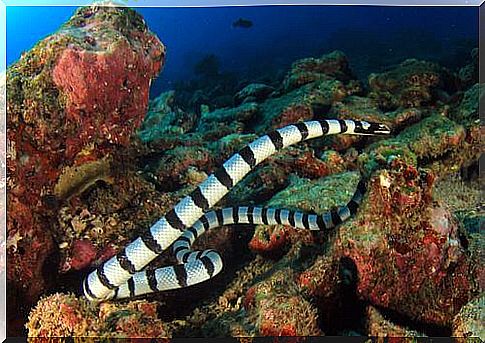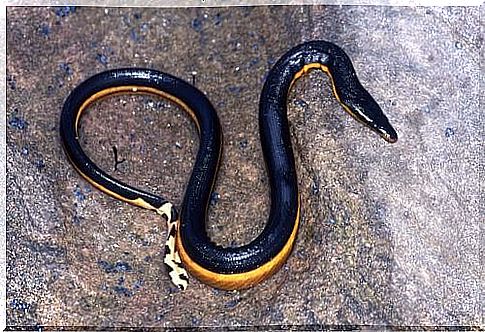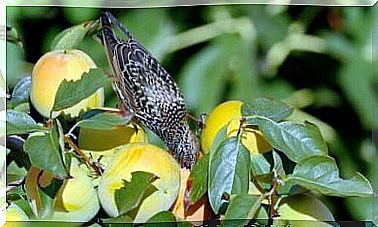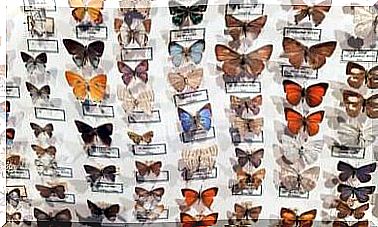Sea Snakes: How Are They Classified?

Sea snakes are a subfamily of reptiles that are totally adapted to aquatic life. Most of them on land are vulnerable and rarely leave the water. In fact, their swimming bodies make it difficult for them to crawl on the ground.
These reptiles are classified into the families of the most venomous snakes in the world ( Elapidae ). The relatives of cobras, mambas and coral snakes belong to these groups. If you want to know more about these fascinating animals, read on.
Sea snakes, but not from the Atlantic
These snakes are adapted to marine life. However, they are not found in the Atlantic Ocean, although the Caribbean regions would be an ideal habitat for these animals.
These reptiles live in the Pacific Ocean and the Indian Ocean, from Japan to New Zealand and from South Africa to Central America. Their absence in the Atlantic is believed to be due to the fact that they are physically unable to reach it, as the Isthmus of Panama is a geological barrier that keeps them separate from this ocean.
However, this has not prevented the proliferation and extension of sea snakes, a group of great biological diversity, consisting of about 62 species classified into 17 different genera. The Hydrophis genus is the largest of these.
There are two subfamilies of sea snakes:
- Hidrophiinae or hydrophins, which includes most of the species. They are completely marine reptiles, which do not need to come to the surface except to breathe, as, unlike fish, they have no gills. They can stay up to five hours underwater.
- Laticaudinae, with a single representative genus with the name Laticauda , which includes eight species. These animals have an amphibious life, as they reproduce on land.
Now let’s take a closer look at each of these two broad categories.
The hydrophins, the real sea snakes
Sea snakes have large anatomical differences from their terrestrial counterparts. For example, they all have a flattened oar-shaped tail, which helps them swim, and the body is flattened to the side, like an eel.
Adults of most species of this subfamily reach a length of between 120 and 150 centimeters. However, the largest specimens can reach three meters in length, such as adults of the Hydrophis spiralis species .
Unlike terrestrial species, which have interlocking scales to protect themselves from abrasion against the ground, the scales of most pelagic sea snakes do not overlap.
While this is a general rule, some species do have overlapping scales. This is the case of those sea snakes that live in the seabed in the presence of corals, to protect their body from the abrasions caused by the coral on their skin.

Hydrophins are carnivorous animals, they feed on fish, especially eels, but also on molluscs, crustaceans and even fish eggs. To hunt, they inject their poison into captured prey, which die soon after due to their toxic effect.
Another difference between the Hidrophiinae subfamily and other snakes is their reproduction, as they are ovoviviparous animals, meaning their young develop and hatch inside the mother. Usually seven to nine pups are born, although in some species there are exceptions with much more progeny.
The venom of sea snakes is very powerful and surpasses that of cobras, being composed of a mixture of neurotoxins and myotoxins. The beaked sea snake is one of the most poisonous species, but human bites are rare and probably due to intrusion into their environment, as this species is quite peaceful.
Amphibious snakes of the genus Laticauda
They too are classified as sea snakes, although they do not spend their entire lives in the water in this case . Their habits are aquatic and terrestrial, since in reality they reproduce on land, and unlike the previous ones they are oviparous, since they lay their eggs on the surface of the earth.
The nostrils of the laticaudas are located on both sides, while in the rest of the sea snakes they are found on the upper part of the snout, which they extract from the water to breathe. These ophidians can close their nostrils by means of valves when they dive.
The yellow-mouthed sea snake ( Laticauda colubrina ) is one of the most representative species. It inhabits the tropical waters of the Indo-Pacific Ocean and is distinguished by its long, almost cylindrical body, with uniform black and silver bands.

As we have seen, sea snakes are divided into two large subfamilies with different characteristics. These snakes have a number of amazing adaptations to the aquatic environment.









